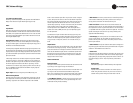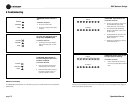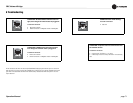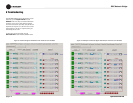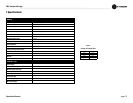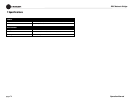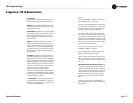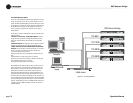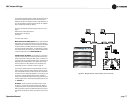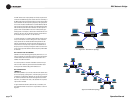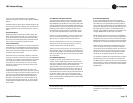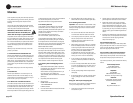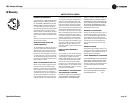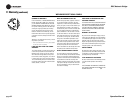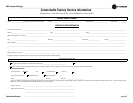
DBC Network Bridge
Operation Manual page 79
Today, commonly available networking cards are 10/100Base-T
capable, which allows them to be used on either 10BaseT or 100Base-T
networks.
Fast Ethernet distance limitations apply to CobraNet installations: 100
meters over Cat-5 copper cable, 2 kilometers over multimode fiber. Pro-
prietary Fast Ethernet via single mode fiber solutions can reach even
further.
8.3.2 Audio Specs
CobraNet implements fixed sample rates of 48 kHz or 96 kHz. Each
channel may be selected to transmit 16-, 20- or 24-bit audio data as
desired. The transmitter and receiver buffering required for reliable
transmission is fixed at 256 samples yielding a network transmission
latency of 5.333 ms (256 samples at 1/48 kHz per sample).
8.3.3 The Conductor
A CobraNet system is coordinated by one of the devices called the Con-
ductor. When two or more CobraNet devices are interconnected prop-
erly, one of the devices will be elected the network conductor based on a
priority scheme. The Conductor indicator will light on the CobraNet
device that is serving as the conductor.
Deterministic transmission on Ethernet is enabled by a protocol that
implements a “Conductor” for control of time-division multiplexing and
clock recovery. The “Conductor” periodically broadcasts a well-defined
“beat” packet onto the network for each transmitter and receiver to
recover synchronous timing information. The “beat” also includes
information as to which addresses can transmit at certain time slots
within the “beat” period.
The Conductor regulates the CobraNet digital audio traffic on the
CobraNet network. Each transmitter is given a “permission” to transmit
in a given time-slot within the Conductor controlled isochronous cycle-
time. The time-slot is determined by the assigned bundle priority.
Higher bundle priorities receive lower-numbered positions and are
transmitted first. The “Receiver Count” monitor indicates how many
devices are receiving the digital audio bundle. The “Active” indicator
indicates whether the particular Bundle is being actively transmitted
onto the network.
8.3.4 Bundles and Audio Channels
All audio channels are packaged into groups called Bundles (formerly
called Network Channels) for transmission over the Ethernet network.
Each CobraNet device has the ability to send and receive a fixed number
of Bundles. The Bundle number tells the CobraNet conductor which spe-
cific CobraNet device is trying to communicate with which other Cobra-
Net device(s) over the network. A given Bundle may have only one
transmitter that places it onto the network. Unicast Bundles may have
only a single receiver. Multicast Bundles may have multiple receivers.
Bundles from 1 to 255 are designated as “multicast” (“broadcast”) Bun-
dles. This means that they are transmitted to multiple receivers. This
type is most used on “repeater” networks limited to 64 channels.
Bundles from 256 to 65,279 are “uni-cast”. This means that they are
transmitted to one and only one receiver. This type is most used on
“switched” networks requiring more than 64 channels.
A Bundle can carry up to 8 audio channels. The usual assignment is 8
channels at 20 bits. Using less audio channels is possible but maximum
size bundles are suggested for most efficient utilization of network band-
width. If 24-bit data is desired, then only 7 audio channels can be loaded
into a single Bundle.
8.3.5 Repeater Networks
CobraNet can operate on “repeater” networks and more complex
“switched” networks. Repeater networks use low-cost Ethernet hubs.
1
On this type of an Ethernet network, all packets are broadcast to all con-
nected nodes. CobraNet multi-cast and uni-cast Bundles can be
assigned but because of the simpler repeater-type hubs, even uni-cast
transmissions are broadcast to all nodes. Therefore, a maximum of 8
full-loaded Bundles (64 audio channels) are allowed on the entire net-
work. More Bundles may be allowed if they are loaded with less than the
full eight audio channels. There is no limit to the number of active
receivers on a repeater network. Generally, a repeater based CobraNet
network must be dedicated to CobraNet traffic only to guarantee reliable
transmission of audio packets.
8.3.6 Switched Networks
A more complex CobraNet network can be built using Ethernet
Switches.
2
Ethernet switching technology is more sophisticated than
hubs. Switches do not simply broadcast each and every packet to all
nodes. Instead, they can interrogate each incoming packet transmission
to determine its destination and (very quickly) transmit the data to only
that destination port. This allows for more overall network traffic. In
effect each port has 100MB of bandwidth and the overall network can be
as large as 100MB times the number of ports on the network.
Switched networks allow both multi-cast and uni-cast CobraNet Bun-
dles. Uni-cast transmissions can only be received by a single node and
are typically used for point-to-point routing. This technique leverages
Ethernet switching technology to significantly conserve overall network
bandwidth and in-turn allow many more Bundles and Audio Channels.
Another enhancement available with most switched network environ-
ments is “full-duplex” links. A full-duplex link allows simultaneous
send and receive over the same Ethernet connection. This allows simul-
taneous send and receive of up to 64 channels per node for a total of
128 channels. That said, please keep in mind that today’s CobraNet
node designs are only capable of 64 channels (32 in and 32 out).
The combination of switching and full-duplex technologies in switched
CobraNet networks allows up to 128 channels per node and greater
than 3000 individual uni-cast channels. There is no limit to the number
of active receivers on a switched CobraNet network. Switched networks
also allow control traffic such as PCs, to coexist on the same network as
CobraNet devices.
2
See Tested Ethernet Products on the Peak Audio website at
www.peakaudio.com/CobraNet for a list of recommended Ethernet
switches.
1
See Tested Ethernet Products on the Peak Audio website for a list of rec-
ommended Ethernet repeaters.



